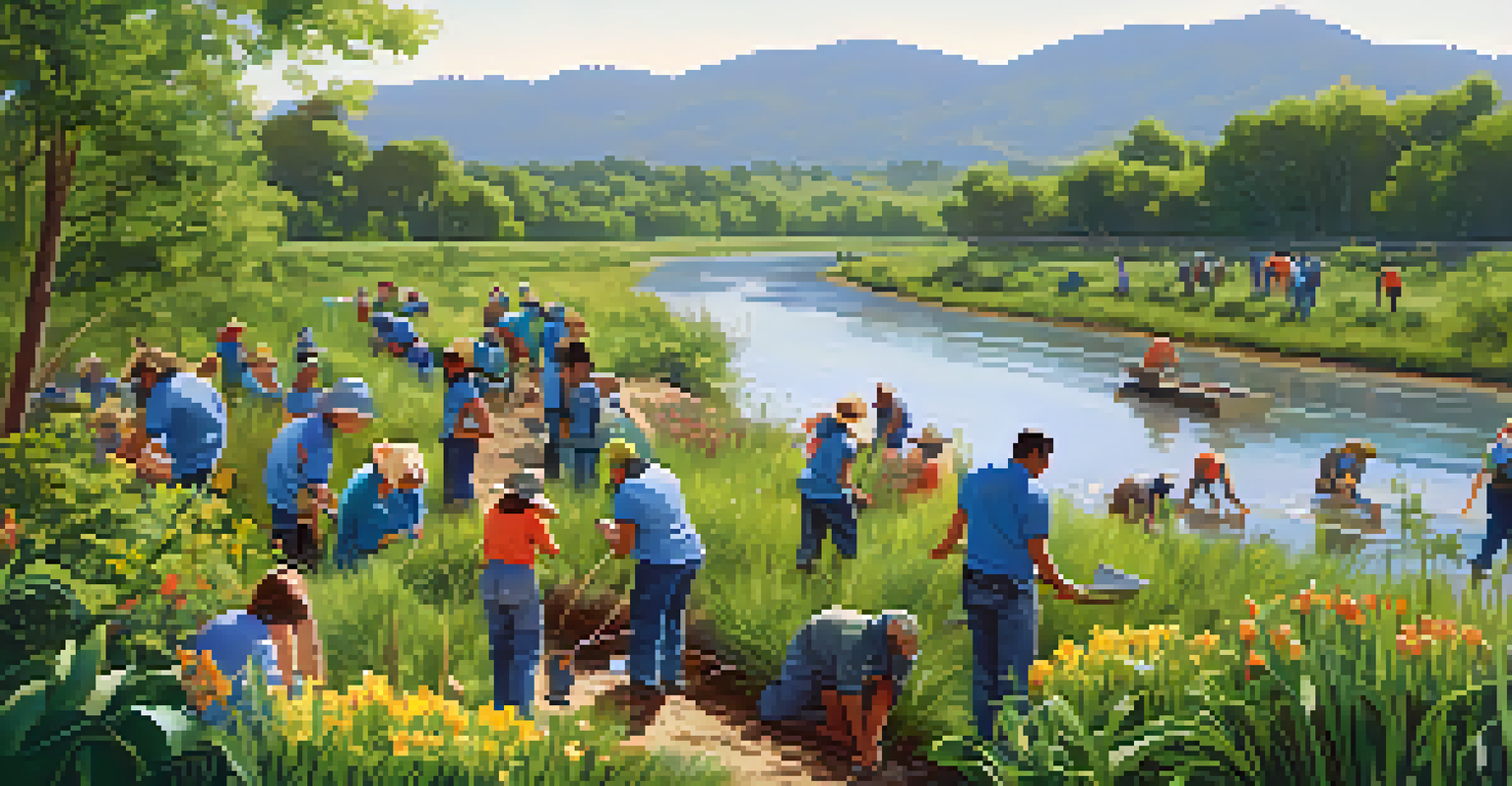Impact of Arizona's Climate on Wildlife Conservation Efforts

Understanding Arizona's Diverse Climate Zones
Arizona is known for its varied climate zones, ranging from arid deserts to lush forests. This diversity creates unique habitats that support a wide array of wildlife, each adapted to specific climatic conditions. For instance, the Sonoran Desert hosts species like the Gila monster, while the ponderosa pine forests are home to the elusive black bear. Understanding these zones is critical for conservationists as they develop tailored strategies to protect the wildlife that inhabits them.
The greatest threat to our planet is the belief that someone else will save it.
The fluctuating temperatures and seasonal variations in Arizona can significantly affect wildlife behavior and habitats. Animals may migrate to find suitable conditions, altering their traditional territories in search of food and shelter. This adaptability is essential for survival but also complicates conservation efforts, as tracking these movements can be challenging. Conservationists must stay informed about climatic changes to anticipate how wildlife might react.
Moreover, climate change exacerbates these challenges, leading to unpredictable weather patterns and extreme events. Increased heatwaves and prolonged droughts can stress animal populations, pushing them to the brink. Consequently, conservation strategies must evolve alongside these climatic shifts to ensure that wildlife can thrive in an ever-changing environment.
The Role of Habitat in Wildlife Conservation
Habitat loss is one of the most pressing issues for wildlife conservation, and Arizona's climate plays a crucial role in this. As temperatures rise, natural habitats may become unsuitable for certain species, leading to a decline in their populations. For example, the Mexican spotted owl depends on specific forest conditions that are threatened by changing weather patterns, making conservation efforts critical in these areas.

Preserving and restoring habitats is essential for maintaining biodiversity in Arizona. Conservationists often focus on creating wildlife corridors that enable animals to migrate safely between fragmented habitats. This is especially important in a state where urban development and agriculture encroach upon natural landscapes, further isolating wildlife populations.
Diverse Climate Affects Wildlife
Arizona's varied climate zones create unique habitats that significantly influence wildlife behavior and conservation strategies.
Additionally, habitat conservation efforts must consider the unique climatic needs of different species. For instance, restoring riparian zones in desert regions can provide crucial resources for species like the endangered California condor. By understanding the interplay between climate and habitat, conservationists can implement more effective strategies to protect Arizona's wildlife.
Challenges of Invasive Species in Arizona
Invasive species pose a significant threat to Arizona's native wildlife, and climate change can exacerbate this issue. Warmer temperatures can create favorable conditions for invasive plants and animals, allowing them to outcompete native species for resources. This shift can lead to drastic changes in ecosystem dynamics, making it harder for conservationists to maintain biodiversity.
In every walk with nature one receives far more than he seeks.
For example, the introduction of non-native plants like buffelgrass has led to increased fire risks in desert areas, altering the habitats of species that rely on those ecosystems. Invasive species not only disrupt food chains but can also introduce diseases that affect native wildlife. Addressing this challenge requires a coordinated effort from conservationists, policymakers, and the public.
Effective management of invasive species involves monitoring their spread and implementing control measures. Conservationists often engage in public education campaigns to raise awareness about the importance of preventing the introduction of invasive species. By fostering community involvement, Arizona can better protect its unique wildlife from the threats posed by these invaders.
Climate Adaptation Strategies for Wildlife
As climate change continues to impact Arizona, wildlife conservationists are developing innovative adaptation strategies. These strategies aim to enhance the resilience of wildlife populations and their habitats. One approach involves creating climate-smart conservation plans that incorporate climate projections into wildlife management practices.
For example, conservationists may prioritize protecting areas that are projected to remain suitable for specific species in the coming decades. This forward-thinking approach can help ensure that wildlife has access to the resources they need as their habitats change. Additionally, habitat restoration efforts can focus on increasing connectivity between landscapes, allowing animals to migrate in response to climatic shifts.
Habitat Loss Threatens Species
As temperatures rise, habitat loss in Arizona poses a critical threat to species like the Mexican spotted owl, necessitating urgent conservation efforts.
Moreover, collaboration among various stakeholders, including government agencies, non-profits, and local communities, is essential for effective climate adaptation. By pooling resources and knowledge, Arizona can implement comprehensive conservation strategies that address both current and future challenges posed by climate change.
Community Involvement in Conservation Efforts
Community involvement is crucial for successful wildlife conservation in Arizona, especially given the state's unique climate challenges. Engaging local communities helps to foster a sense of stewardship and responsibility towards natural resources. When residents understand the importance of preserving wildlife and habitats, they are more likely to participate in conservation initiatives.
Educational programs and volunteer opportunities can empower locals to take action in their own backyards. For instance, community-led projects to restore native plants can help support local wildlife. Moreover, citizen science initiatives allow individuals to contribute to data collection, helping conservationists monitor wildlife populations and habitat conditions.
Collaboration between conservation organizations and communities can also lead to innovative solutions. By incorporating local knowledge and experiences, these partnerships can develop strategies that are more effective and culturally relevant. Ultimately, a united effort will enhance the resilience of Arizona's wildlife in the face of climate change.
The Importance of Research in Conservation
Research plays a vital role in understanding the impacts of Arizona's climate on wildlife conservation efforts. Ongoing studies help identify the vulnerabilities of different species and ecosystems, providing valuable insights for conservation planning. For example, researchers may track changes in migration patterns or breeding behaviors in response to climate fluctuations.
Moreover, scientific research helps inform policy decisions that can lead to effective conservation strategies. By providing data on species distributions and habitat conditions, researchers can advocate for necessary protections and funding. This evidence-based approach ensures that conservation efforts are grounded in scientific understanding, increasing their chances of success.
Community Involvement is Key
Engaging local communities in conservation initiatives fosters stewardship and enhances the effectiveness of wildlife protection efforts in Arizona.
Collaborative research initiatives that involve universities, government agencies, and conservation organizations can amplify these efforts. By sharing knowledge and resources, Arizona can develop comprehensive strategies that address both immediate and long-term challenges posed by climate change on wildlife.
Future Outlook for Wildlife Conservation in Arizona
The future of wildlife conservation in Arizona hinges on our ability to adapt to a changing climate. As environmental conditions continue to evolve, conservationists must remain vigilant and flexible in their approaches. This may involve revisiting existing strategies and prioritizing proactive measures that can mitigate the impacts of climate change on wildlife.
Investing in innovative technologies and practices can also enhance conservation efforts. For instance, utilizing satellite imagery and advanced tracking systems can provide real-time data on wildlife movements and habitat conditions. This information is invaluable for making informed decisions about conservation priorities and resource allocation.

Ultimately, the success of wildlife conservation in Arizona will depend on collaboration among various stakeholders, including government agencies, non-profits, researchers, and the public. By working together and embracing a forward-thinking mindset, we can create a brighter future for Arizona's wildlife, ensuring that these unique species continue to thrive in the face of climate challenges.